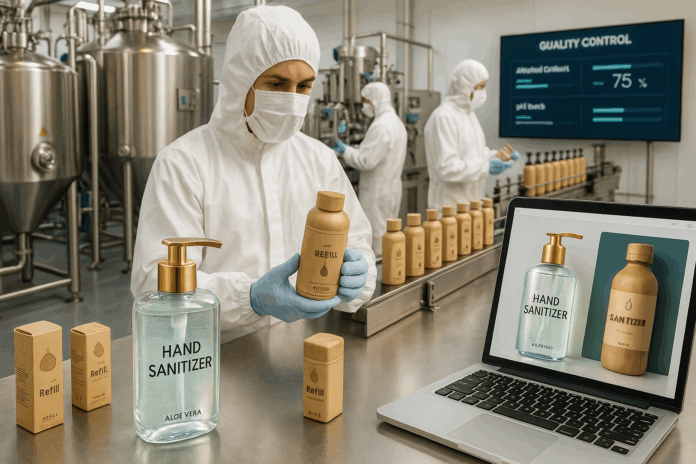The Post-COVID Hand Sanitizer Landscape
Let’s start with a truth bomb: the hand sanitizer industry isn’t the wild west it was in 2020. Back then, everyone from craft distilleries to cosmetics brands rushed to fill shelves with hastily mixed gels. Today? The dust has settled, but the stakes are higher than ever. Demand has stabilized, but consumers are pickier, regulations are stricter, and competition is brutal.
Here’s the good news: hygiene isn’t a passing trend. Studies project steady growth, with the market climbing at 7.31% annually through 2030. But surviving this new era means mastering three pillars: quality, branding, and innovation. Let’s unpack how to turn these challenges into your competitive edge.
Navigating Quality Standards and Regulatory Compliance
A. Global Regulatory Frameworks
If you’re still treating compliance as a checkbox, you’re playing with fire. Post-COVID regulations are no longer lenient. The FDA and WHO now enforce strict benchmarks:
- Alcohol content: 60–95% ethanol or isopropyl alcohol.
- Additives: Glycerol (to prevent skin cracking) and hydrogen peroxide (to kill spores) are mandatory in WHO-approved formulas.
- Cleanroom standards: ISO 14644 certification ensures sterile production environments.
Temporary pandemic-era loopholes? Gone. For example, the FDA now rigorously flags methanol contamination—a toxic shortcut some producers took during shortages. Fail here, and you’ll join the 32% of Ethiopian manufacturers whose products were recalled in 2022 for subpar ethanol levels.
B. Avoiding Common Pitfalls
- Methanol madness: It’s cheaper, but it’s also poisonous. The FDA’s “Do-Not-Use” list grows yearly—don’t end up on it.
- Expiration dates matter: Alcohol degrades. If your product smells like vinegar or separates, it’s useless. Store batches in cool, dark spaces to extend shelf life.
- Document like your business depends on it (because it does). Detailed records of formulations, batch testing, and audits aren’t just for regulators—they’re your shield during lawsuits.
C. Case Study: Lessons from Ethiopia
A 2022 study found only 12% of hand sanitizers in Ethiopia met hydrogen peroxide standards. Why? Many small producers skipped testing to cut costs. Result? Lost consumer trust and legal battles. Your takeaway: Invest in third-party lab testing upfront, or pay far more later.
Branding Strategies for Differentiation
A. Consumer-Driven Trends
Forget the basic blue gel. Today’s buyers want sanitizers that multitask:
- Skincare hybrids: Aloe vera and vitamin E aren’t extras—they’re expectations. Brands like Touchland dominate by marketing sanitizers as “hand skincare,” with chic, moisturizing gels sold at Sephora.
- Sustainability sells: Refillable dispensers (think Noshinku’s bamboo containers) reduce plastic waste and build loyalty.
- Luxury appeal: Travel-sized sprays with bergamot or lavender scents let you charge premium prices.
B. Digital Marketing & E-Commerce
Instagram isn’t just for selfies. Use it to:
- Partner with micro-influencers in skincare or wellness niches.
- Run demos showing your sanitizer’s texture (no sticky residue!) or eco-friendly packaging.
- Optimize product listings for keywords like “natural hand sanitizer” or “vegan antibacterial spray.”
C. Case Study: Touchland’s Playbook
Touchland’s revenue jumped 300% post-COVID by ignoring pharmacies and targeting Ulta Beauty instead. Their pastel-colored mist bottles, endorsed by Disney collabs, turned sanitizers into impulse buys. Lesson? Position your product where your audience shops—not where “sanitizers” traditionally sit.
Surviving Market Saturation
A. Niche Markets
Generic sanitizers are a race to the bottom. Profit lies in specialization:
- Healthcare partnerships: Hospitals pay premium prices for medical-grade gels (80%+ ethanol) in sterile, single-use pouches.
- Corporate customization: Create branded batches for hotels (mini bottles with custom scents) or airlines (TSA-compliant sizes).
B. Innovation & R&D
- Target superbugs: Develop formulas effective against MRSA or C. difficile—hospitals will pay triple.
- AI-driven production: Algorithms can predict raw material price swings or optimize mixing times, slashing costs by up to 15%.
C. Strategic Collaborations
Team up with unlikely allies:
- Distilleries like Bacardi repurposed ethanol during COVID. Partner with them for sustainable, local alcohol sourcing.
- Packaging startups can help design biodegradable bottles—a PR win and cost-saver.
D. Cost Management
- Bulk buying: Procter & Gamble cuts costs by producing 45,000 liters weekly. Even small players can negotiate better rates by sourcing glycerol from biofuel byproducts.
- Waste = lost cash: Reprocess denatured alcohol scraps into sanitizing wipes or surface cleaners.
Future-Proofing Your Business
The hand sanitizer game isn’t about surviving—it’s about evolving. Here’s your roadmap:
- Quality is non-negotiable. One recall can bankrupt you.
- Brand like you’re selling luxury, not germs. Think skincare, not survival.
- Innovate or stagnate. AI, niche markets, and sustainability aren’t buzzwords—they’re profit centers.
The next frontier? Hybrid work culture. Imagine sanitizer subscriptions for offices or gyms. Or compact UV-light dispensers that refill bottles automatically. Stay agile, stay curious, and remember: In a saturated market, the bold thrive.
Now go make something worth selling—and make sure it’s something people want to buy.


